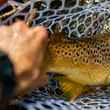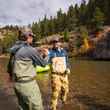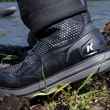Experienced trout fishermen who have learned to succeed in the gamut of weather and water conditions presented throughout the year relish high water for its habit of rearranging fish into predictable, concentrating holding locations and bringing the river’s biggest, most aggressive citizens out to play. Likewise, the spring high water period on secondary rivers and streams represents a fantastic window of opportunity for small stream fishermen to catch their biggest fish of the year.
Consider these points to change your game in high water and make the most of this window.
Fish Big Fish Water
It should go without saying, but is often not considered. When the water comes up and big fish become more vulnerable to angling efforts, put in your hours on streams known for (or rumored to hold) big fish. It’s very unlikely you’ll pull a trophy from a stream not capable of supporting a trout into old age. If brown trout fin the waters, even better.
Pick Your Shots
When rivers rise, trout relocate into soft seams and pillows behind rocks along the banks of the river where they can cruise for disoriented prey, and sometimes in the very bottoms of deep pools where current can rush by delivering food without requiring much energy expenditure to retain position. Large trout will occupy such prime lies. Search for these, and fish them well. Utilize predictability. Don’t waste time and energy wading and maneuvering to fish unlikely pieces of water.

Throw Big
Cold, early-season trout aim to stash big, calorie-rich meals in their tanks to recover from winter lethargy. As water temperatures rise into the upper 40s and past the 50-degree mark, trout become more active.
So, too, do crayfish and minnows—two staple foodstuffs for large trout. High, warming water, in environments where crayfish over-winter by burrowing in the bank, pulls the arthropods out of hibernation. Minnows are disoriented by high water, which requires them to shuffle about searching for new holding areas, making them more vulnerable prey. Trout notice these changes, and adjust their menus accordingly.
Thus, impressionistic streamer patterns fished at an appropriate speed, relative to water temperature and trout activity, will take big fish.

Beef Up Your Tackle
Fish heavy—a heavier rod and heavier tippet—and consider your options for fly presentation.
If you normally fish a stream with a four-weight, consider swapping it out for a six- or seven-weight. In heavy current, even a 12-inch rainbow can test a limber four-weight. A beefier stick will assist in casting larger flies, and will be better suited to wage war with a swollen-river beast.
When fishing high water, I typically start with a 2X or 3X tippet (depending on water clarity) and scale down if I don’t see results. You’ll need the larger diameter for casting larger flies; you can often get away with it in high, turbulent water; and you’ll need it when the One eats.
As far as fly presentation goes, make sure your fly is finding the bottom and moving slowly. This can be achieved with split shot or sink tips. I’ve even had success in smaller streams with tungsten-weighted leaders. The options are many.
Know How to Get Out
Norman Maclean’s character spends many a paragraph visualizing a fight with a not-yet-hooked trout and analyzing the Blackfoot River for a place to land a potential fish—something small-stream fishermen, not used to tangling with large fish, often never think about.
When water is high and ripping and wading is limited and dangerous, this is imperative, as a hooked fish’s immediate move is often downstream, and the current is a willing facilitator. Take a mental note of unwadable holes, strong currents, and sweepers along the bank. Plan your escape route, and execute it safely as soon as a fish is hooked.
Once you’ve learned the ins and outs of fishing secondary streams at high water for trout, you won’t be able to think about anything else after a spring rain. Give these tips a shot, and hold on.































Comments
FRANK CADA replied on Permalink
Great article. Thinking and fishing outside the box can be very productive. this article is about moving water. Some of these concepts apply to Stillwater, when it is not so still. When the weather is bad, fishing lakes can be great. Thunderstorms churn the water near shore where most food is. Nuff said.
Pages